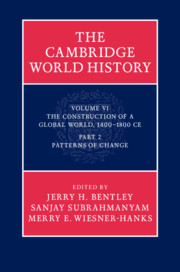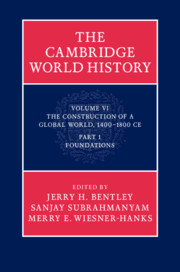84 results
Revisiting “Racial Capitalism”
-
- Journal:
- European Journal of Sociology / Archives Européennes de Sociologie / Volume 64 / Issue 2 / August 2023
- Published online by Cambridge University Press:
- 06 September 2023, pp. 173-181
-
- Article
- Export citation
Looking out from Goa, 1648: Perspectives on a crisis of the Estado da Índia
-
- Journal:
- Modern Asian Studies / Volume 55 / Issue 6 / November 2021
- Published online by Cambridge University Press:
- 29 March 2021, pp. 1755-1794
- Print publication:
- November 2021
-
- Article
- Export citation
Between Eastern Africa and Western India, 1500–1650: Slavery, Commerce, and Elite Formation
-
- Journal:
- Comparative Studies in Society and History / Volume 61 / Issue 4 / October 2019
- Published online by Cambridge University Press:
- 03 October 2019, pp. 805-834
-
- Article
- Export citation
A View from Mecca: Notes on Gujarat, the Red Sea, and the Ottomans, 1517–39/923–946 H.*
-
- Journal:
- Modern Asian Studies / Volume 51 / Issue 2 / March 2017
- Published online by Cambridge University Press:
- 06 April 2017, pp. 268-318
- Print publication:
- March 2017
-
- Article
- Export citation
One Asia, or Many? Reflections from connected history*
-
- Journal:
- Modern Asian Studies / Volume 50 / Issue 1 / January 2016
- Published online by Cambridge University Press:
- 05 January 2016, pp. 5-43
- Print publication:
- January 2016
-
- Article
- Export citation

The Cambridge World History
-
- Published online:
- 05 May 2015
- Print publication:
- 09 April 2015
Copyright page
-
- Book:
- The Cambridge World History
- Published online:
- 05 May 2015
- Print publication:
- 09 April 2015, pp vi-vi
-
- Chapter
- Export citation
Preface
-
- Book:
- The Cambridge World History
- Published online:
- 05 May 2015
- Print publication:
- 09 April 2015, pp xvii-xx
-
- Chapter
- Export citation
Figures
-
- Book:
- The Cambridge World History
- Published online:
- 05 May 2015
- Print publication:
- 09 April 2015, pp xii-xiii
-
- Chapter
- Export citation
Part Four - Crossroads regions
-
- Book:
- The Cambridge World History
- Published online:
- 05 May 2015
- Print publication:
- 09 April 2015, pp 345-444
-
- Chapter
- Export citation
Index
-
- Book:
- The Cambridge World History
- Published online:
- 05 May 2015
- Print publication:
- 09 April 2015, pp 474-492
-
- Chapter
- Export citation
Copyright page
-
- Book:
- The Cambridge World History
- Published online:
- 05 May 2015
- Print publication:
- 09 April 2015, pp vi-vi
-
- Chapter
- Export citation
17 - On early modern historiography
- from Part Four - Questions of Method
-
-
- Book:
- The Cambridge World History
- Published online:
- 05 May 2015
- Print publication:
- 09 April 2015, pp 425-445
-
- Chapter
- Export citation
Tables
-
- Book:
- The Cambridge World History
- Published online:
- 05 May 2015
- Print publication:
- 09 April 2015, pp xv-xv
-
- Chapter
- Export citation
Part Four - Questions of Method
-
- Book:
- The Cambridge World History
- Published online:
- 05 May 2015
- Print publication:
- 09 April 2015, pp 423-473
-
- Chapter
- Export citation
Dedication
-
- Book:
- The Cambridge World History
- Published online:
- 05 May 2015
- Print publication:
- 09 April 2015, pp vii-vii
-
- Chapter
- Export citation
Part One - Migrations and Encounters
-
- Book:
- The Cambridge World History
- Published online:
- 05 May 2015
- Print publication:
- 09 April 2015, pp 1-100
-
- Chapter
- Export citation
Maps
-
- Book:
- The Cambridge World History
- Published online:
- 05 May 2015
- Print publication:
- 09 April 2015, pp xiv-xiv
-
- Chapter
- Export citation
Part Two - Trade, Exchange, and Production
-
- Book:
- The Cambridge World History
- Published online:
- 05 May 2015
- Print publication:
- 09 April 2015, pp 101-310
-
- Chapter
- Export citation

The Cambridge World History
-
- Published online:
- 05 May 2015
- Print publication:
- 09 April 2015



